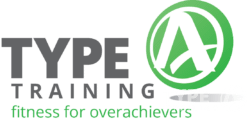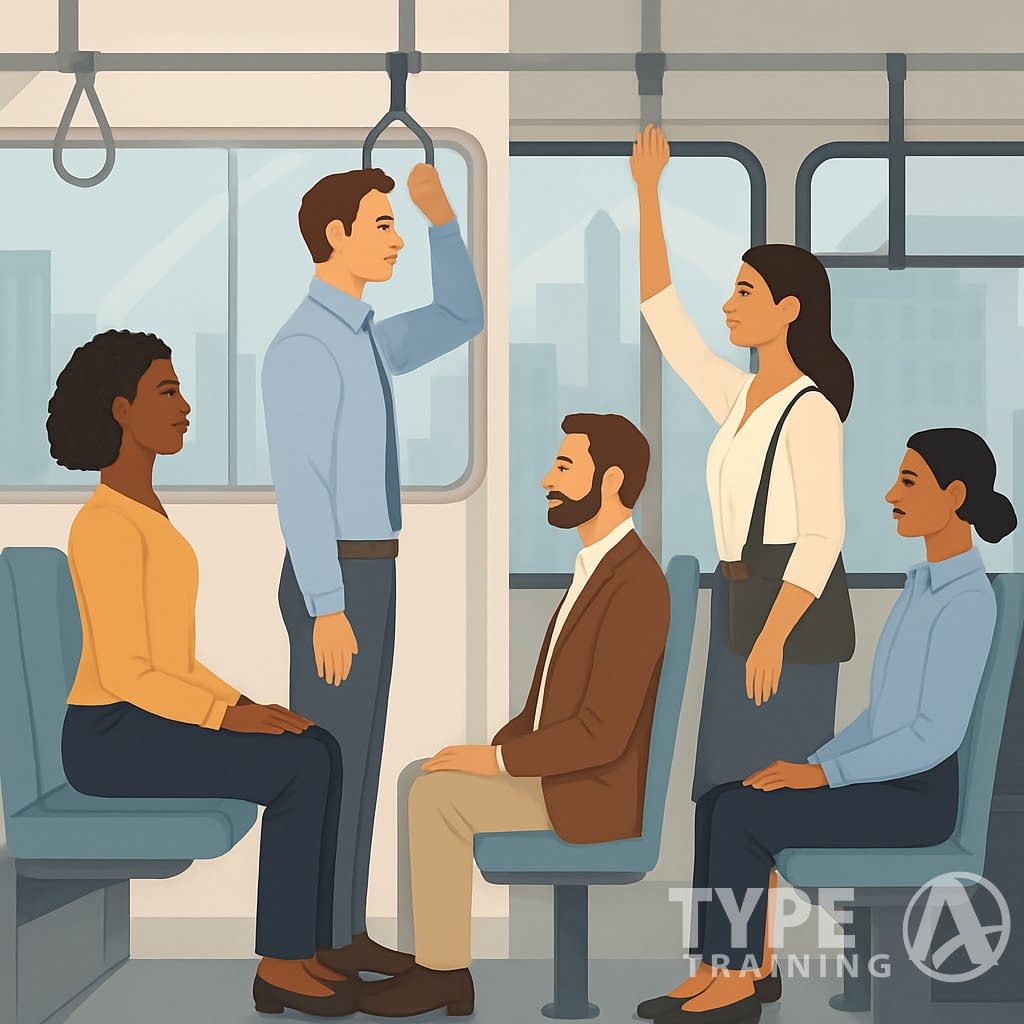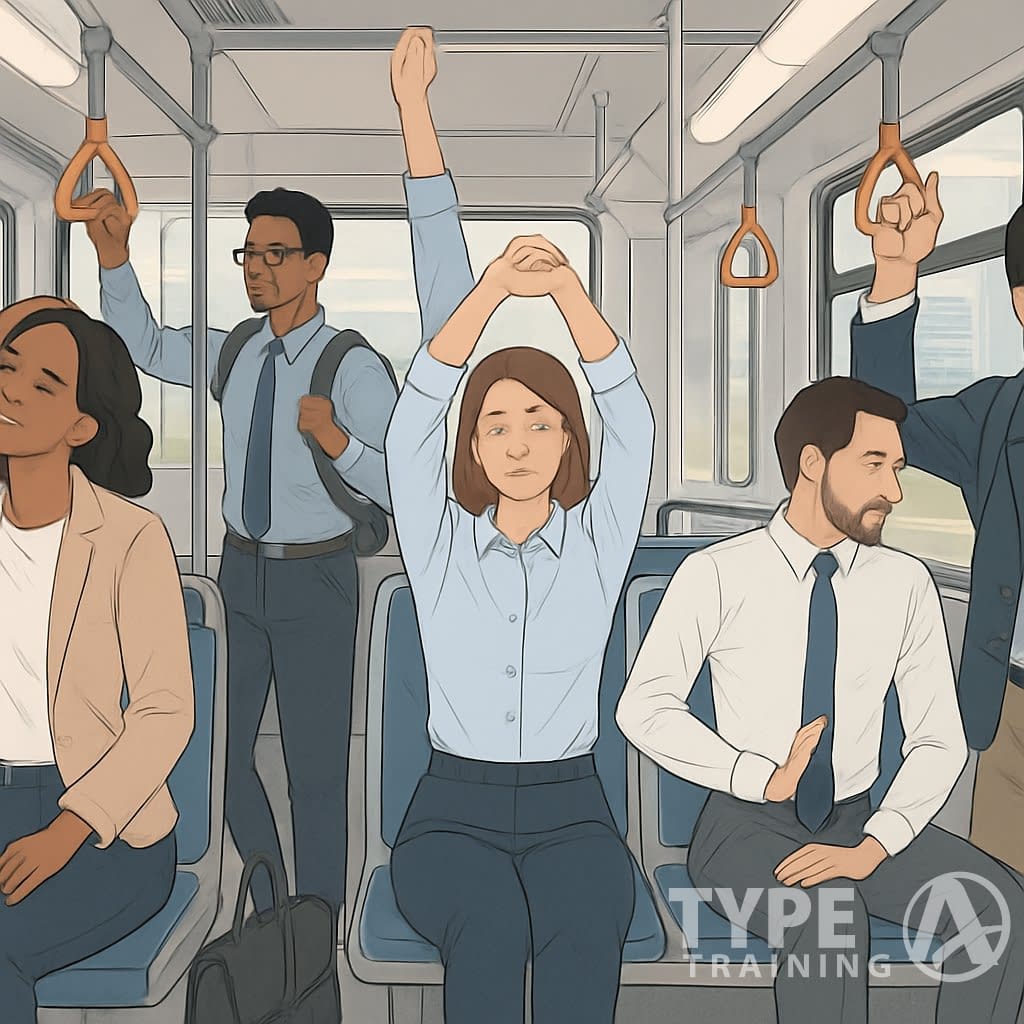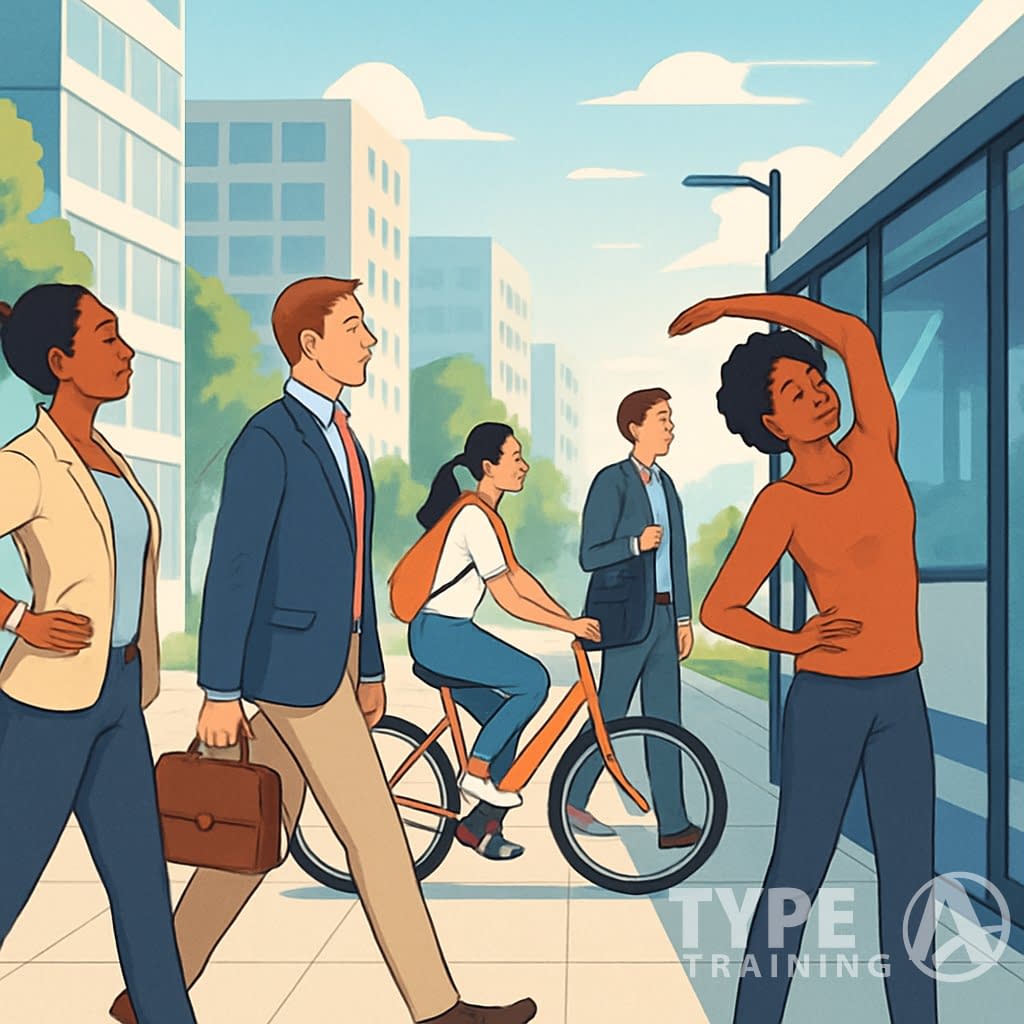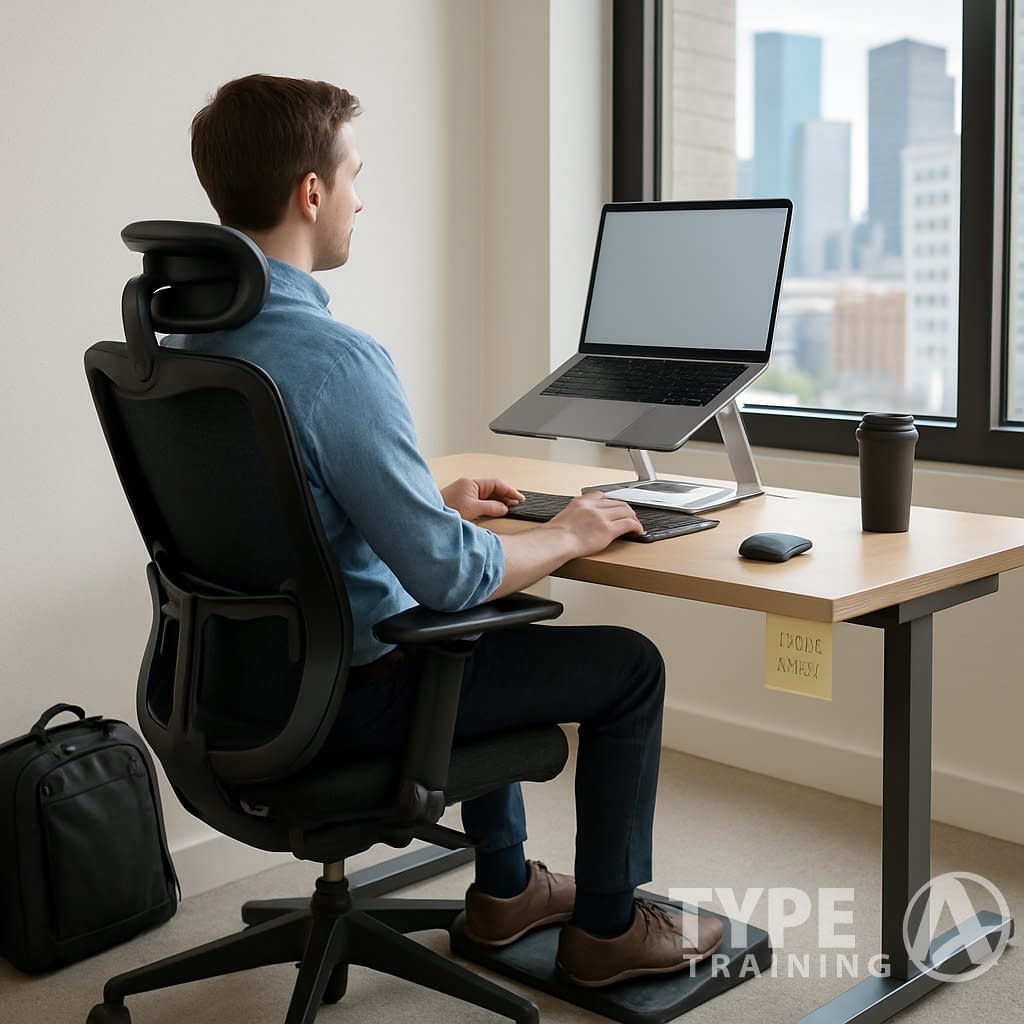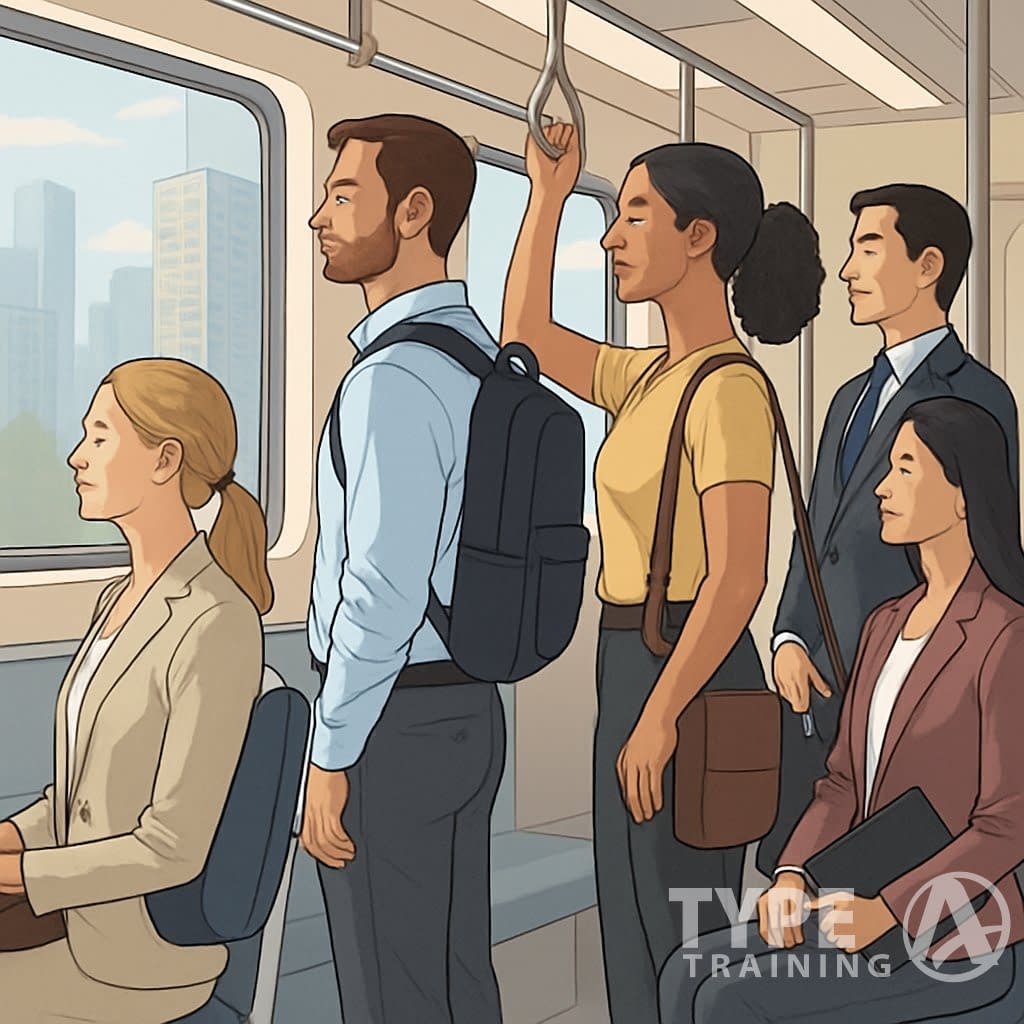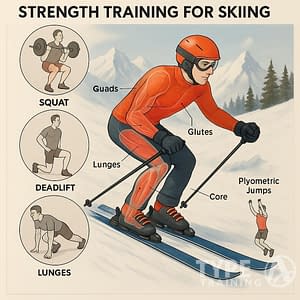Your daily commute might be quietly messing with your posture, and you might not even notice. Whether you’re driving for an hour or packed into a crowded train, all that sitting and device-hunching piles up.
Implementing posture hacks for professionals can significantly enhance your daily travel experiences.
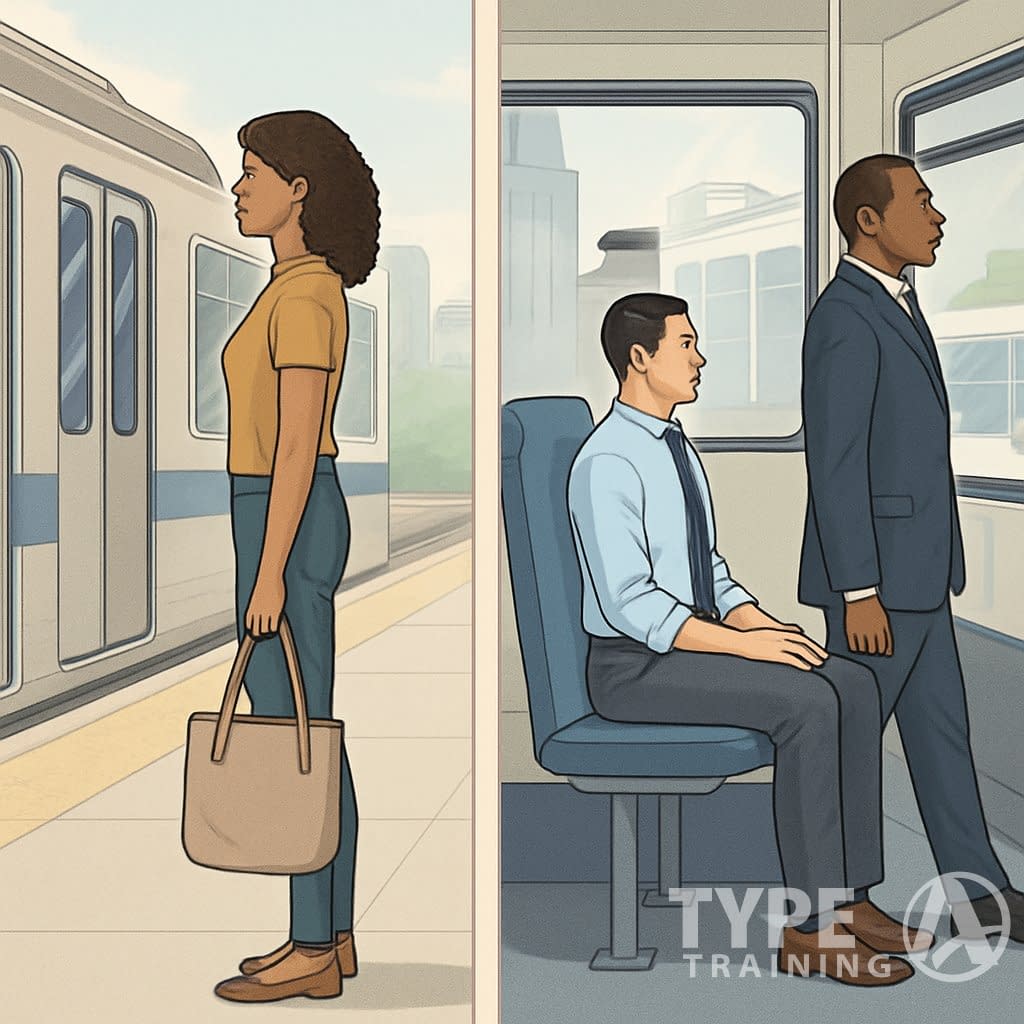
The average commuter spends about 30 minutes each way getting to work. That adds up to hours every week where your body just isn’t in the best position.
Popular posts:
Utilizing effective posture hacks for professionals ensures comfort during those long hours of commuting.
Simple tweaks to how you sit, stand, and move during your commute can prevent long-term back pain and improve your overall posture. You don’t need fancy gadgets or a complete lifestyle overhaul.
Incorporating these simple posture hacks for professionals can help maintain a healthy spine.
Small changes—like adjusting your seat, doing quick stretches at red lights, or just moving with a bit more awareness—can turn your commute into a chance for better health.
Remember, these posture hacks for professionals are all about making small, manageable changes.
These strategies work no matter how you get to work. Drive, take the train, walk—there’s something here for everyone.
These posture hacks for professionals are designed to fit seamlessly into your routine.
Key Takeaways
-
- Daily commuting can mess with your posture, leading to back and neck pain
Explore various posture hacks for professionals to enhance your commuting experience.
-
- Adjusting your seat and using better body positioning helps prevent spinal stress and muscle tension
These posture hacks for professionals can be integrated into any commuting method.
- Quick exercises and stretches during your commute can help undo some of the damage
Understanding the Impact of Commuting on Posture
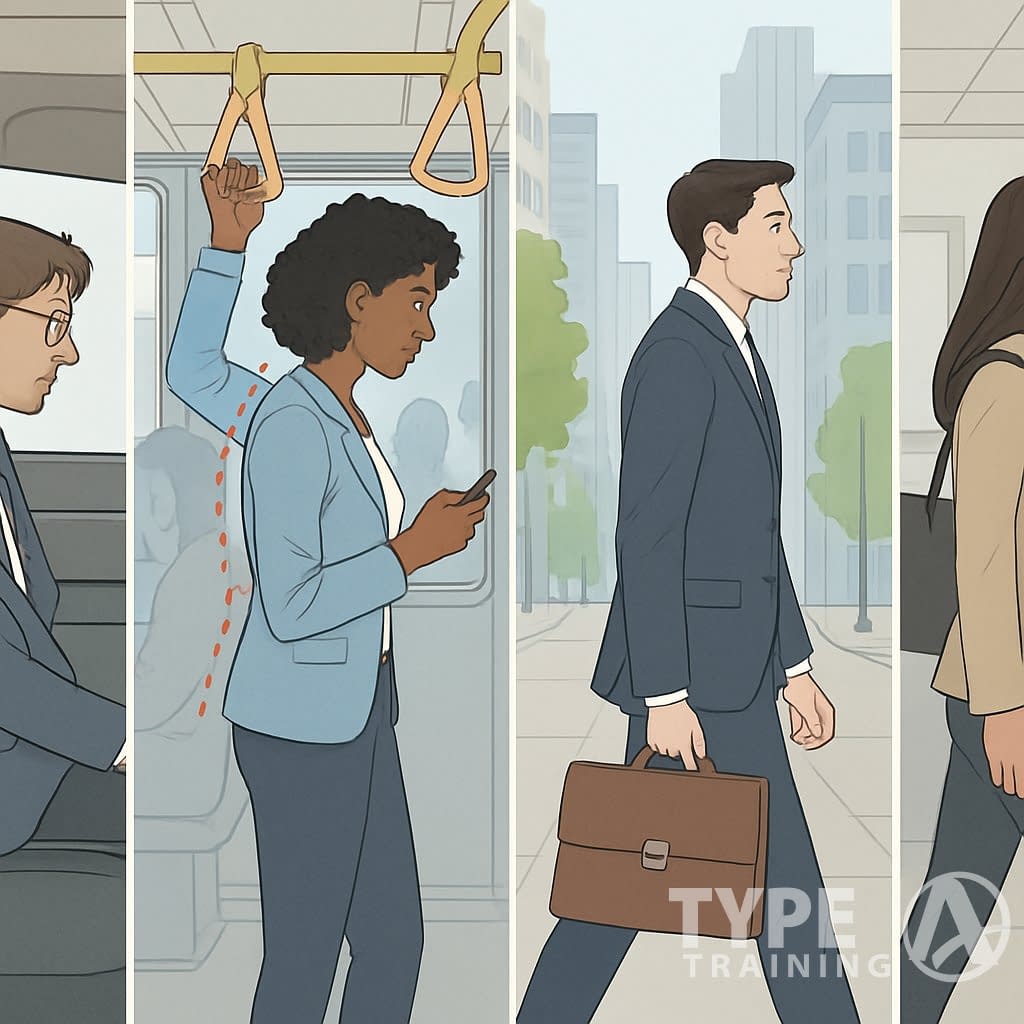
Understanding posture hacks for professionals can lead to better health outcomes.
Commuting creates physical stress that goes right to your spine and muscles. If you spend 30 minutes each way, that’s a lot of time every week in less-than-ideal positions.
Adopting posture hacks for professionals is essential for long-term comfort.
How Long Commutes Affect Spinal Alignment
Sitting for long stretches in your car or on the train pushes your spine into a C-shaped curve. That compresses your vertebrae and puts pressure on your discs.
Incorporating posture hacks for professionals during your commute can yield significant benefits.
Your pelvis tilts backward, which pulls your lower back out of its natural curve. Tension builds up from there.
Key spinal changes during commuting:
-
- Your head juts forward by 2-3 inches
- The lumbar curve flattens by 15-20 degrees
- Hip flexors get tighter
Employing posture hacks for professionals can help alleviate discomfort during travel.
- The upper back rounds more than it should
Standing commuters deal with a different set of problems. Long periods on buses or trains make your weight shift unevenly, creating muscle imbalances up and down the body.
Even standing commuters can benefit from posture hacks for professionals.
When you hold a static position, your core muscles just check out. Without core support, your spine leans on ligaments and discs for stability.
Common Posture Problems Among Daily Commuters
Tech neck is everywhere—almost 80% of regular commuters who use their phones get it. Your head moves forward, which strains the neck.
Explore effective posture hacks for professionals to combat tech neck.
Rounded shoulders show up from gripping steering wheels or handrails. The chest tightens, upper back muscles get stretched and weak.
Driver-specific issues include:
-
- Left shoulder rides higher if you use the armrest
- Right hip gets tight from the gas pedal
Implementing posture hacks for professionals can also address driver-specific issues.
- Spine twists when you reach for controls
- Sitting on a wallet can compress the sciatic nerve
Public transit brings its own quirks. Carrying a bag on one shoulder throws you off balance. Grabbing overhead handles rounds your upper back.
Slouched sitting becomes almost automatic after a while. Your body starts to think this is the new normal, even as it causes problems.
Find yourself using posture hacks for professionals to combat slouched sitting.
Your pelvis shifts backward, which shortens your hamstrings and weakens your glutes. It’s a domino effect for muscle issues.
Health Risks Linked to Poor Commuting Posture
Chronic back pain hits about 40% of people with commutes over 45 minutes. Poor posture can ramp up disc pressure by up to 300%.
Immediate symptoms include:
-
- Stiff neck and headaches
- Achy lower back
- Tension between the shoulder blades
Understanding posture hacks for professionals can prevent chronic pain.
- Tight hip flexors
Long-term, things get worse. Discs can herniate or wear out faster, and bone spurs may develop from uneven stress.
Muscle imbalances weaken stabilizing muscles like your deep core, glutes, and upper back. They lose strength and don’t coordinate as well.
Remember to incorporate posture hacks for professionals during your workday.
Cardiovascular effects sneak in too. Sitting too long makes blood pool in your legs, which bumps up clot risk. Your metabolism slows, which throws off blood sugar.
Nerve compression gets more common. Sciatica, carpal tunnel, and thoracic outlet syndrome all show up more in commuters.
Compressed ribcages lead to shallow breathing. Less oxygen means more fatigue at work—not exactly ideal.
Utilizing posture hacks for professionals can lead to better overall wellness.
Essential Posture Hacks for Your Commute
Your daily commute throws a lot at your spine—lots of sitting and not much movement. But you can fight back with a few simple adjustments.
Implementing posture hacks for professionals during your daily commute is crucial.
Choosing Ergonomic Transit Options
Pick seats that support your natural spine curve if you can. On trains and buses, the aisle usually gives you more legroom and lets you shift around.
Choosing the right seating can enhance posture hacks for professionals.
Seat Selection Priorities:
- Go for firm cushioning, not seats that swallow you up
- Look for good back support, or bring your own
- Make sure there’s enough legroom to keep your knees at 90 degrees
- Sit where you can get up easily for a quick stretch
If you’re taking a rideshare, sitting behind the driver gives you more space for your legs than the other side.
When driving, raise your seat so your hips are a bit higher than your knees. Let your thighs rest on the seat, but don’t let the edge dig into the backs of your knees.
Slide your seat close enough to the pedals so your knees stay slightly bent. Reach the steering wheel with a soft bend in your elbows.
Seated Positioning for Spinal Health
Your seated positioning can significantly impact posture hacks for professionals.
Keep both feet flat on the floor or a footrest. Crossing your legs might feel comfy but can mess with blood flow and muscle balance.
Press your back against the seat. Let your shoulders touch the backrest, but keep a little space behind your lower back.
Proper Sitting Alignment:
Following these sitting guidelines can enhance your posture hacks for professionals.
-
- Head stacked over shoulders
- Shoulders relaxed and even
- Arms bent at about 90 degrees
- Hips at 90 degrees too
- Feet flat and facing forward
Proper alignment is key when applying posture hacks for professionals.
Shift positions every 20-30 minutes. Even small adjustments—like leaning on a different arm—help.
Keep your phone and other stuff within reach. Twisting or stretching for things just adds strain.
Supportive Gear for Maintaining Alignment
A lumbar roll or small pillow under your lower back can do wonders. Place it at belt level for best support.
Neck pillows help if they support your neck’s curve without pushing your head forward. Firm ones hold up better than soft, floppy foam.
Using supportive gear is essential in your posture hacks for professionals arsenal.
Essential Support Items:
-
- Lumbar cushion: Firm, about 4-6 inches thick
- Neck pillow: U-shaped or cylindrical
- Seat cushion: 2-3 inches thick for hard seats
Investing in quality support items can enhance your posture hacks for professionals.
- Footrest: Handy for shorter folks
Portable seat cushions add support to squishy transit seats. Memory foam or gel cushions keep their shape better.
A small footrest lets you keep your feet flat if the seat’s too high. That keeps pressure off the backs of your legs and helps your hips stay aligned.
Easy Exercises and Stretches During Commute
Smart commuters squeeze in little movements to fight off stiffness. These moves help prevent muscle tightness, boost blood flow, and keep pain at bay.
Engaging in exercises alongside posture hacks for professionals can promote mobility.
Seated Core Engagement Techniques
Abdominal breathing is the base for core activation while sitting. Put one hand on your chest and one on your belly. Take a deep breath so your belly hand rises more than your chest hand.
Pelvic tilts are easy to do in your seat. Tilt your pelvis forward and backward, keeping your back against the seat. Hold each tilt for a few seconds.
Try seated marching at stoplights or train stops. Lift one knee slightly, hold briefly, then switch. This wakes up your hip flexors and core.
Simple movements like seated marching can complement posture hacks for professionals.
Glute squeezes are sneaky—nobody will notice. Squeeze your butt muscles, hold for five seconds, then relax. Do 10-15 reps to keep those muscles firing.
Neck and Shoulder Mobility Movements
Neck rolls help shake off tension from staring forward. Gently roll your head from shoulder to shoulder in a half-circle. Don’t roll backward to avoid strain.
Shoulder blade squeezes fight forward head posture. Pull your shoulder blades together like you’re pinching a pencil between them. Hold for a few seconds.
Using shoulder mobility movements reinforces posture hacks for professionals.
Chin tucks build neck strength and reset alignment. Pull your chin back, making a double chin (yeah, it looks goofy). This undoes that forward head creep.
Gentle side neck stretches loosen things up. Tilt your ear toward your shoulder, hold for 15-20 seconds, then switch sides. Keep the opposite shoulder relaxed.
Leg and Ankle Activation Routines
Ankle circles keep blood moving and fight swelling. Lift a foot and make circles with your ankle, then switch.
Incorporating leg activation routines enhances your posture hacks for professionals.
Calf raises work even in tight spaces. Rise up onto your toes, pause, then lower back down.
Heel and toe taps wake up different leg muscles. Tap your heels with toes down, then tap toes with heels down.
Seated leg extensions build thigh strength if you have space. Straighten one leg, hold, lower it gently, then switch. Do 10-15 reps per leg.
Incorporating Movement Into Your Daily Route
You can sneak movement into your commute without losing time. Walking a bit more, taking the stairs, or hopping off transit a stop early all help.
Finding ways to move more aligns perfectly with posture hacks for professionals.
Walking and Biking Alternatives
Swap short car rides for walking or biking when you can. Even a 10-minute stroll to grab coffee wakes up your core and keeps your spine happy.
Walking benefits for posture:
- Activates deep core muscles
- Loosens tight hips
- Helps your spine stay in line
Park further away to add extra steps. Instead of circling for the closest spot, just head to the far end of the lot.
Biking works your back and opens up your hips. Keep your shoulders relaxed and avoid hunching over. Adjust your seat so your legs get a good stretch.
Start small if you’re new to active commuting. Walk to nearby meetings, or bike to the train station instead of taking the bus.
Adopting biking alternatives can enhance the effectiveness of posture hacks for professionals.
Using Stairs Instead of Elevators
Stairs fire up your glutes and core, and they build leg strength. These muscles keep your posture solid all day.
Proper stair climbing form:
Using stairs regularly can boost the effectiveness of posture hacks for professionals.
- Look up, not down
- Keep your shoulders back
- Engage your core
- Step with your whole foot
- Use the handrail for balance, not to pull yourself up
Start with one flight if you’re used to elevators. Add more as you get stronger.
Quick posture resets can be achieved through effective posture hacks for professionals.
Take two steps at a time sometimes to work different muscles. It challenges your balance and fires up your hips.
Use stairs as quick posture resets during long days. A fast trip up and down can realign your spine and wake you up.
Getting Off a Stop Early for Extra Steps
Hop off public transit a stop early to sneak in an extra 5-10 minutes of walking. It’s a gentle way to wake up your body before the desk grind.
A quick walk after sitting on the train or bus helps your hips loosen up. Try taking longer strides to stretch those tight hip flexors.
Benefits of pre-work walking:
Pre-work walking is among the best posture hacks for professionals to implement.
- Wakes up sleepy glute muscles
- Loosens up stiff hip flexors
- Boosts blood flow to your legs
- Gets your posture ready for the day
Plan a bit of extra time into your morning for this longer route. Leaving 10 minutes earlier helps you avoid rushing, so you can actually walk tall instead of speed-walking hunched over.
Pick safe, well-lit paths if you’re out early or late. It’s smart to map things out ahead of time so you’re not dodging construction or crossing hectic intersections.
Desk and Workplace Strategies for Commuters
A well-structured workspace complements posture hacks for professionals.
Arriving stiff from your commute? Your workspace matters even more. A good setup and targeted stretches can undo a lot of that travel tension.
Maintaining good posture is crucial, and integrating posture hacks for professionals helps.
Quick Desk Stretches
Start with a neck and shoulder release as soon as you get to your desk. Sit up straight and gently tilt your head to the right, holding for 15 seconds, then switch sides.
Roll your shoulders back five times, then forward five times. That helps undo that classic commuter hunch.
Spinal twists are great after being stuck in one position. Put your right hand on your left knee and gently twist your torso left. Hold for 20 seconds, then swap sides.
If your hips feel tight, try a seated figure-four stretch. Cross your right ankle over your left knee and lean forward gently.
Stretch out your wrists and forearms too. Hold your right arm out, palm up, and use your left hand to pull your fingers back for 15 seconds.
Try to do these stretches within half an hour of arriving at work. Your body will thank you.
Optimizing Your Workstation Setup
Set your monitor at eye level to save your neck from more strain. The top of the screen should line up with your eyes.
Adjust your chair so your feet touch the floor and your thighs stay parallel to the ground. Aim for your knees at a 90-degree angle.
Keep your keyboard and mouse close so your elbows stay at your sides. No need to reach and strain your shoulders.
If your lower back is tight, lumbar support is a must. A small pillow or rolled towel works if your chair isn’t cutting it.
Utilizing lumbar support is among the critical posture hacks for professionals.
Keep the stuff you use most within easy reach. That way you’re not twisting around and making things worse.
Lighting from the side is easier on your eyes. If the light’s behind or in front of your monitor, you’ll end up squinting and shifting around.
Scheduling Regular Movement Breaks
Set reminders every 45-60 minutes to get up and move. Commuting leaves you stiff, so these breaks matter even more.
Take a quick 2-3 minute walk—water cooler, restroom, whatever works. It’s a simple way to break up all that sitting.
If you get a call, stand up or walk around while you talk. Even just standing in place is better than nothing.
Regular movement breaks amplify the benefits of posture hacks for professionals.
Take the stairs if you can. It’s a nice change from the elevator and gets your blood moving.
Try a walking meeting for one-on-one chats. You’ll get stuff done and shake off that chair fatigue.
A longer 10-15 minute walk at lunch can reset your posture and give you a burst of energy for the afternoon.
Building Lasting Posture Habits as a Commuting Professional
Building good habits is key, and incorporating posture hacks for professionals helps.
Building good posture habits takes some daily effort and a bit of creativity. If you commute with others, you can hold each other accountable to your posture goals.
Tracking Progress and Setting Reminders
Set phone alerts every 30 minutes during your commute to check your posture. It’s a small nudge, but it works.
Use a simple tracker to keep tabs on your progress:
| Time | Posture Check | Notes |
|---|---|---|
| 8:00 AM | Good | Remembered to adjust seat |
| 8:30 AM | Fair | Caught myself slouching |
| 9:00 AM | Good | Used neck stretch |
Download a posture reminder app that buzzes when you lean too far forward. These are handy if you’re glued to your phone on transit.
Jot down a quick posture rating from 1-10 in your notes app. Write what helped or what tripped you up.
Stick a note on your dashboard or train seat—just a “sit tall” or “shoulders back.” It sounds basic, but those little reminders add up.
If you drive, try adjusting your rearview mirror higher. You’ll have to keep your head up to see, which helps your neck.
Staying Motivated With Commuting Buddies
Find a coworker who commutes the same way and do posture check-ins together. It’s easier to remember when someone else is doing it too.
Make it a challenge: who can remember the most shoulder rolls or neck stretches this week?
Share photos of your improved workspace setups. It’s a fun way to keep each other honest.
Using posture hacks for professionals with a buddy system enhances accountability.
Set up a quick text system for posture reminders. A simple “posture check?” can save you hours of slouching.
Start a workplace wellness group focused on posture. Meet up once a month, swap tips, and celebrate small wins.
Use a group fitness app to track your stretching sessions together. It’s way easier to stick with it when you know someone else is, too.
Ask your buddy to point out if they see you slouching. Sometimes you don’t notice until someone else says something.
For the complete posture training system, check out The Ultimate Guide to Posture Training for Busy Professionals.
Frequently Asked Questions
Clarifying posture challenges through effective posture hacks for professionals is essential.
Commuters have a unique set of posture challenges. The right seat setup, support gear, simple exercises, and taking breaks can make a real difference.
Incorporating posture hacks for professionals can revolutionize your daily commute.
What are the best sitting positions to maintain good posture while driving?
Implement these posture hacks for professionals for lasting benefits.
Sit with your back flat against the seat, making full contact from shoulders to lower back. Keep your knees bent at 90 degrees and feet flat on the pedals.
Keep your head right over your shoulders—don’t lean forward. Try not to slouch or lean to one side while you drive.
Hold the wheel at 9 and 3 o’clock. That keeps your arms relaxed and your spine better aligned.
How can I adjust my car seat for optimal spinal alignment during long commutes?
Raise your seat so your hips are level with or a bit higher than your knees. This takes pressure off your lower back.
Set the seat back to a 100-110 degree angle. Too upright feels stiff, but too reclined will have you craning your neck.
Essential Posture Hacks for Professionals During Your Commute
Move your seat close enough that your legs stay slightly bent when you press the pedals. You shouldn’t have to stretch.
Specific posture hacks for professionals can be life-changing for frequent commuters.
Adjust the headrest so it touches the back of your head, not your neck. The top should line up with your head.
What type of lower back support is recommended for frequent drivers?
A lumbar support cushion keeps the natural curve in your lower spine. Pick one that fits the small of your back without shoving you forward.
Memory foam cushions are a good bet—they mold to your shape and don’t flatten out quickly.
If your car seat has built-in lumbar controls, use them to create a gentle curve. It should feel supportive, not awkward.
Skip cushions that are super thick or rigid. They can mess up your alignment and cause new aches.
Can certain exercises alleviate the impact of a lengthy commute on posture?
Neck stretches help with that forward head posture from watching the road. Gently tilt your head side to side and look over each shoulder.
Shoulder rolls release tension from gripping the wheel. Roll your shoulders back in slow circles a few times.
Core exercises help you hold good posture longer. Try simple abdominal squeezes at red lights.
Back extensions can counter the hunched driving position. Gently arch your back, using your hands for support.
What are effective stretches for professionals to do after a long drive to work?
Hip flexor stretches are key after sitting. Step one foot forward into a lunge and hold for 30 seconds.
Chest doorway stretches open up your shoulders. Put your forearm against a doorframe and step forward to stretch your chest.
Cat-cow stretches on hands and knees bring back spinal mobility. Alternate between arching and rounding your back.
Neck side bends relieve tension from holding your head still. Gently pull your ear toward your shoulder and hold.
How frequently should I take breaks and change positions during my commute to prevent stiffness?
Try to pull over for a break every 30-60 minutes on longer drives. Even stopping for just a couple of minutes gives you a chance to stretch and reset your posture.
When you hit a rest stop, get out and walk around a bit. Stretch your legs—seriously, it helps your blood flow and keeps your muscles from locking up.
If you can, tweak your seat position every 15-20 minutes. Just a small shift now and then helps stop those annoying pressure points from forming.
Stuck at a traffic light? Sneak in a shoulder roll or try these neck stretches. Little moves like that keep you looser during the drive.
